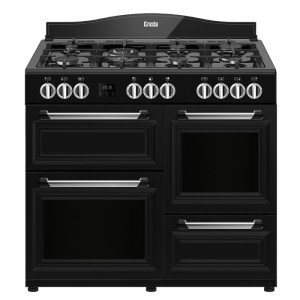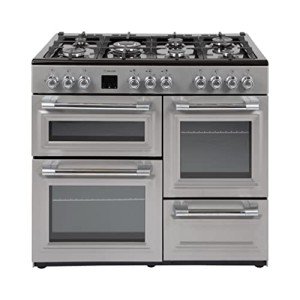 Range Dual Fuel Cooker
Range Dual Fuel CookerRange dual fuel cookers combine a gas cooktop and an electric oven. They're more expensive than all-gas or all-electric models, but offer a combination of precision and flexibility.
Cosmo's models are available in widths of 30, 36, and 48 inches, with one or more ovens. The stovetop has five burners, which includes an enormous ring that can accommodate the wok.
Gas Cooktop
A dual fuel range cooker lets cooks enjoy the best value dual fuel range cooker of both worlds, offering a fast cooking temperature control with even heating in the oven. The cooktop features burners that run on natural gas or propane for a quick and powerful flame. Some models come with an adjustable grille that can be reversible for more versatility. The ovens that are included in these stoves can vary from 4.5 cubic feet to over 6.6 cubic feet, which makes them suitable for many household requirements.
When you are looking to purchase a new kitchen appliance, it is important to think about the type of cooking you'll be doing and how much room you have in your home. For example large ovens that have high BTUs are better to cook meats or other dishes requiring dry heat. Smaller ovens are ideal for baking delicate items. It's also worth considering the type of burner you'll need. The majority of ranges have between four and six burners, however, there are models with up to eight burners and two ovens for larger families.
If you decide a dual fuel range is the right choice for your home, you should look for models that include an electric and gas oven to make the most of its features. For instance this GE model has an 5.3-cubic foot oven with five burners, including two of the strongest power burners in our tests. It also comes with an integrated, reversible griddle and Wi-Fi connectivity for remote monitoring and feature upgrades.
This Samsung smart range oven dual fuel comes with a large cavity and two smaller ones with a ceramic divider. Halibut can be cooked on one side while roasting potatoes in the other. The cooktop comes with gas burners, and an oven with an electric element to ensure even baking.
Eva Bleyer, a review analyst at the Good Housekeeping Institute Kitchen Appliances and Innovation Lab where she has tested over 100 ranges in the past few years. She has interviewed experts from the industry and visited kitchen appliance showrooms in order to find out what technologies are coming to home kitchens. She's spent a lot of time in the kitchen, cooking for herself and others. She has used her vast knowledge to come up with the ideas for this article.
Electric Oven
Dual fuel ranges combine the gas cooktop and electric oven to give you the best of both worlds. Dedicated chefs and home cooks look for these multi-functional models because they offer power and accuracy. Gas stovetops offer rapid heating and plenty of temperature control, while electric oven components cycle in patterns that maximize heat distribution.
If you're looking to master new cooking techniques, a gas stove can help you make the perfect sear on a steak or flambe a coq au vin. For baking, an electric oven's dry, even heat makes it easier to bake cakes or roast chicken. This site has a wide range of gas-powered ovens.
Like other appliances that require two distinct sources of power--a natural or liquid propane gas line and a 120-volt electrical outlet. The specific requirements vary by model, so consult the owner's manual for the exact gas and electrical connections needed for your range. Typically, an electrician is required to adjust the electric voltage of your outlet to meet the needs of your dual fuel range.
Dual fuel ranges combine the sensitivity of gas cooktops with the electric ovens' heat distribution to create a powerful kitchen appliance capable of meeting any culinary challenge. Dual fuel ranges also unlock advanced cooking options that aren't offered on stoves that are solely fuelled, such as self-cleaning cycles or convection options.
Explore our range of JennAir dual fuel ranges that come with a gas stovetop and an oven. Choose from a variety of sizes, finishes, and design styles to complement your kitchen. You can customize your cooktop by adding features such as our raised pedestal star(r) burners, porcelain maintops, and range dual fuel Cooker griddle. Hydraulic SoftClose hinges (r) prevent slamming and allow easy access to the warming drawer and oven. Certain models come with an integrated hood and an a griddle that can be swapped out, while others offer the possibility of adding an air fryer or convection oven.
Electronic Controls
A dual fuel range cooktop is a versatile and powerful cooker that can provide the responsiveness of gas cooktops and the consistent heat in electric ovens. This kind of stove is ideal for those who want to experiment with new recipes and use sophisticated techniques, such as grilling peppers. It can also add an elegant look to high-end kitchens and elevate any home's interior design.
Dual fuel ranges have become popular with professional chefs as well as cooks at home. Aside from their superior heat control, these stoves offer other valuable features that help them stand out from the competition.
For example, some models come with a customizable cooktop surface that lets you customize the look and layout of your burners to suit your culinary style. Other options may include integrated dishwashers, built-in microwaves or warming drawers. This allows you to customize the cooking capabilities of your cooktop and optimize workflow in your kitchen.
Depending on the model that you choose, some commercial dual fuel range cookers fuel ranges can be coupled with electric or gas convection ovens. These ovens offer an exceptionally precise temperature control, which can be difficult to achieve using regular gas ovens. These ovens can also come with features that make baking easier. For instance, a Dual VertiFlow System which reduces cold or hot spots in the Oven. Or Gourmet Mode that allows cook more complex dishes, such as eclairs.
Gas ovens are well-known for their rapid response time and hands-on cooking. electric ovens provide a more uniform heating across the entire surface of the oven. This makes them ideal for baked goods and casseroles that require uniform temperatures and consistent browning. Gas ovens with higher BTU ratings are ideal for cooking meats and other meals that require moisture.
While the flexibility offered by dual fuel ranges is a major draw, these stoves can be more expensive than all-electric or gas models. This can be a deterrent for those on a budget. A dual fuel range requires both the use of gas and an electrical hookup in order to function, which can be an expensive upfront expense. In some cases you might need to pay an electrician to change the electric voltage of your outlet or install a new gas line.
Installation
If you select a dual fuel range cooker, you're choosing a range that has gas hobs that heat up immediately with ovens that can regulate temperatures precisely for baking. These versatile cookers are suitable for a wide range of dishes including sauteing, searing, and steaming to roasting. Explore Abt's selection of electric and gas ranges to find one that is suitable for your needs.
Check out our range of ranges that slide into or stand alone if you want to find a kitchen range that will fit in with your space. Our ranges come with dual-fuel options that are designed to fit into the counters flush in order to create a seamless appearance in your kitchen.
Before you begin installation, make sure you go through the owner's manual and follow the steps that are provided. Consider hiring a professional if you are not confident in connecting the gas or electrical connections. You should also have at least one person assist you in moving the appliance.
The first step to install dual fuel cooker range fuel ranges is to ensure that your gas hook-up is set to accommodate the new appliance. A professional can install a gas line that is dedicated to the appliance. You could also use an existing electrical line. Verify the quality of the line and ensure it is able to provide power to an electric oven.
To install the gas line, start by removing the existing cap from the gas valve and cleaning the area. If necessary, you can enlarge the hole in your wall to accommodate the larger diameter pipe. After the gas line has been installed, simply screw the connector or tube into the valve. Don't overtighten the threads.
When you're finished you're done, tighten the screw on the green ground terminal ring of the wire. Connect the other end of the cable to the white terminal block wire and match the colors (red to black and black to red). Install the screw into the terminal block. Re-insert ring and secure cord by using strain relief.
 📌 Range Dual Fuel Cooker Techniques To Simplify Your Daily Lifethe One Range Dual Fuel Cooker Trick Every Individual Should Be Able To
🔍 검색
🎥 Range Dual Fuel Cooker Techniques To Simplify Your Daily Lifethe One Range Dual Fuel Cooker Trick Every Individual Should Be Able To 유튜브 검색
📌 Range Dual Fuel Cooker Techniques To Simplify Your Daily Lifethe One Range Dual Fuel Cooker Trick Every Individual Should Be Able To
🔍 검색
🎥 Range Dual Fuel Cooker Techniques To Simplify Your Daily Lifethe One Range Dual Fuel Cooker Trick Every Individual Should Be Able To 유튜브 검색

